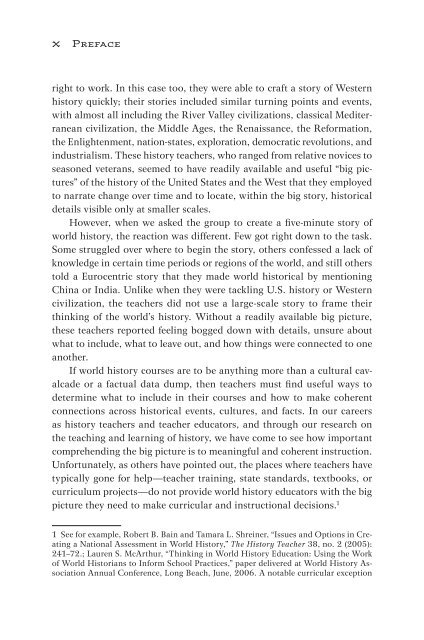This Fleeting World
This Fleeting World
This Fleeting World
You also want an ePaper? Increase the reach of your titles
YUMPU automatically turns print PDFs into web optimized ePapers that Google loves.
Preface<br />
right to work. In this case too, they were able to craft a story of Western<br />
history quickly; their stories included similar turning points and events,<br />
with almost all including the River Valley civilizations, classical Mediterranean<br />
civilization, the Middle Ages, the Renaissance, the Reformation,<br />
the Enlightenment, nation-states, exploration, democratic revolutions, and<br />
industrialism. These history teachers, who ranged from relative novices to<br />
seasoned veterans, seemed to have readily available and useful “big pictures”<br />
of the history of the United States and the West that they employed<br />
to narrate change over time and to locate, within the big story, historical<br />
details visible only at smaller scales.<br />
However, when we asked the group to create a five-minute story of<br />
world history, the reaction was different. Few got right down to the task.<br />
Some struggled over where to begin the story, others confessed a lack of<br />
knowledge in certain time periods or regions of the world, and still others<br />
told a Eurocentric story that they made world historical by mentioning<br />
China or India. Unlike when they were tackling U.S. history or Western<br />
civilization, the teachers did not use a large-scale story to frame their<br />
thinking of the world’s history. Without a readily available big picture,<br />
these teachers reported feeling bogged down with details, unsure about<br />
what to include, what to leave out, and how things were connected to one<br />
another.<br />
If world history courses are to be anything more than a cultural cavalcade<br />
or a factual data dump, then teachers must find useful ways to<br />
determine what to include in their courses and how to make coherent<br />
connections across historical events, cultures, and facts. In our careers<br />
as history teachers and teacher educators, and through our research on<br />
the teaching and learning of history, we have come to see how important<br />
comprehending the big picture is to meaningful and coherent instruction.<br />
Unfortunately, as others have pointed out, the places where teachers have<br />
typically gone for help—teacher training, state standards, textbooks, or<br />
curriculum projects—do not provide world history educators with the big<br />
picture they need to make curricular and instructional decisions. <br />
See for example, Robert B. Bain and Tamara L. Shreiner, “Issues and Options in Creating<br />
a National Assessment in <strong>World</strong> History,” The History Teacher 38, no. 2 (2005):<br />
241–72.; Lauren S. McArthur, “Thinking in <strong>World</strong> History Education: Using the Work<br />
of <strong>World</strong> Historians to Inform School Practices,” paper delivered at <strong>World</strong> History Association<br />
Annual Conference, Long Beach, June, 2006. A notable curricular exception


